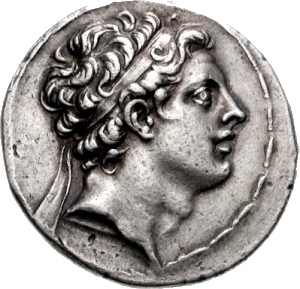The Maccabean Revolt, Lawrence H. Schiffman, Reclaiming the Dead Sea Scrolls, Jewish Publication Society, Philadelphia, 1994.
 The ascension of Antiochus IV Epiphanes (175–164 B.C.E.) to the Seleucid throne continued to fuel the political instability in Palestine that had resulted from the constant Ptolemaic-Seleucid warfare. In a move certain to provoke the Jewish population, Antiochus sold the office of high priest, traditionally a hereditary succession, to Jason, the highest bidder. Jason also bought the right to establish in Jerusalem a gymnasium and an ephebion (a Hellenistic school), intending, through such centralized educational and cultural institutions, to turn the city into a Hellenistic polis. The right to live according to the Torah, granted to the Judaeans by Antiochus III, was now rescinded. In its place, the Jews were to live under the law of the Greek city. Jews suddenly found themselves second-class citizens under an oligarchy. The Hellenized aristocracy, on the other hand, saw many benefits to the new reforms- citizenship in a Greek city, trade with other such cities, the minting of coins, and other advantages particularly attractive to the wealthy and powerful.
The ascension of Antiochus IV Epiphanes (175–164 B.C.E.) to the Seleucid throne continued to fuel the political instability in Palestine that had resulted from the constant Ptolemaic-Seleucid warfare. In a move certain to provoke the Jewish population, Antiochus sold the office of high priest, traditionally a hereditary succession, to Jason, the highest bidder. Jason also bought the right to establish in Jerusalem a gymnasium and an ephebion (a Hellenistic school), intending, through such centralized educational and cultural institutions, to turn the city into a Hellenistic polis. The right to live according to the Torah, granted to the Judaeans by Antiochus III, was now rescinded. In its place, the Jews were to live under the law of the Greek city. Jews suddenly found themselves second-class citizens under an oligarchy. The Hellenized aristocracy, on the other hand, saw many benefits to the new reforms- citizenship in a Greek city, trade with other such cities, the minting of coins, and other advantages particularly attractive to the wealthy and powerful.
Even with these political and commercial changes, the Temple and its rituals continued according to the ancient tradition. Yet Jason’s brand of Hellenization was not enough for some. Amidst violent struggles between moderate and extreme Hellenizers and political intrigue connected with the supporters of Ptolemies and Seleucids, foreign deities were introduced into the Temple, creating further friction. To extreme Jewish Hellenizers, the ancestral God of Israel was simply another manifestation of the supreme deity known in Syria as Baal Shamin (Master of Heaven) and in the Greek world as Zeus Olympius.
The earliest attempts at organized rebellion were probably led by the Hasidim, a group of pietists who found the religious compromises in Hellenistic Jerusalem totally unacceptable. Rebellion was mounting, and Antiochus acted to stem it.
To do so, he enacted the infamous persecutions. Understanding all too well that the only way to defeat the rebels was by attacking the forces that inspired them—the Torah, the commandments, and the culture of the Jewish people—Antiochus struck at the heart of Jewish practice. But his actions had precisely the opposite effect from the one he intended. After years of struggle and insurrection, fueled by the Jewish Hellenizers’ attempts to foist their way of life on the entire nation of Israel, the Jews reached their boiling point and struck back.
Antiochus’s persecutions were enacted in the winter of 167–166 B.C.E. Foreign idolatrous worship and cultic prostitution were introduced into the Temple in December 167 B.C.E. Throughout Palestine, the Sabbath and Festivals were to be violated. High places were built where unclean animals were to be offered. Circumcision was outlawed. The laws of kosher food were not to be observed. The penalty for violating these ordinances was death.
Throughout the land Jews found themselves confronted by officials who sought to enforce the new regulations with a vengeance, burning Torah scrolls and executing those who hid them. The stage was now set for confrontation of two opposing forces—the Jewish people and the Seleucids. The appearance of the Hasmonaean (Maccabean) family would soon ignite the flames of full-scale revolt.
Several thousand rebels coalesced around the Hasmonaean family, led by Judah the Maccabee and his brothers John, Simon, Eleazar, and Jonathan. This army began to take control of villages throughout the countryside. By 166–165 B.C.E., they had taken Judaea.
Under Judah the Maccabee (hammer), the Jewish armies defeated successive Seleucid generals, who attempted to put down the uprising. In December of 164 B.C.E., Judah and his men took Jerusalem, and on the 25th of the Hebrew month of Kislev, Judah purified the Temple and reorganized the sacrificial worship to conform to the Jewish tradition. This event is commemorated in the Jewish holiday of Hanukkah (rededication). The main objective of the revolt—elimination of the persecutions and restoration of Judaism to the nation—had been achieved.
Next, Judah undertook wars throughout the Land of Israel to extirpate paganism from the country and eliminate Hellenizing rivals. Judah was killed in battle against the Seleucids in 160 B.C.E. The Hasmonaeans now rallied around Jonathan, his brother. Again the Hellenized Jews sought to rule, and again the Hasmonaeans plagued them on all sides. For several years, the post of high priest remained vacant as war raged. Finally, responding to competing offers from both sides vying for succession to the Syrian throne, Jonathan, with the support of the Syrian pretender Alexander Balas, appeared in the robes of the high priest on the Festival of Sukkot (Tabernacles) in the year 152 B.C.E. A dynasty had dawned that would rule the Jewish people until the coming of the Romans in 63 B.C.E.
Pages 69-71



